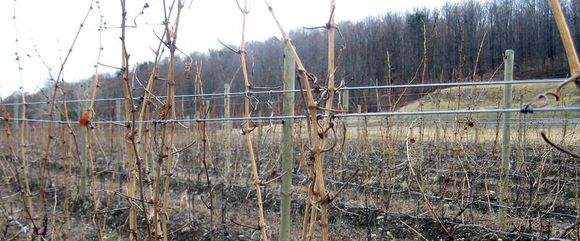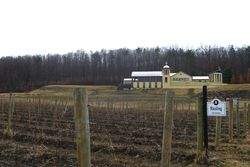Breaking Bad: Growers Hope Heat Wave Won’t Spark Early Budbreak

By Evan Dawson, Finger Lakes Editor
Photos courtesy Heron Hill Winery
Don't blame the growers. Yes, they are like the real-life manifestation of Goldilocks, complaining when things are a little too cold or a little too hot. Yes, they are like your annoying friend who is never satisfied with a date, or a menu or a movie. But they are only taking up for their vines, and in New York state, vines are easily dissatisfied.
And so it is with consternation that growers look to the upcoming forecast.
Kids will be playing, golf balls flying, grills firing, but growers will be fretting when the mercury swells to near 80 degrees in the Finger Lakes — and into the 70s on Long Island. Budbreak typically occurs during the first week of May, with some mild variation based on spring weather. But the coming heat — coupled with an unusually warm March — have the vines excited already.
Why is this a problem? Because when the buds break, a hard frost could devastate the crop. And the risk for a hard frost doesn't recede "until the first full moon in May," says Damiani Wine Cellars grower Phil Davis.
But what if buds break early… and no hard frost hits? "Wouldn't that be something?" Davis muses with a smile. "A long growing season and no frost. But I wouldn't bet on having no frost. It's too long a time to avoid it."
Finger Lakes report: Ready to burn hay if necessary
"It's a little too much, too fast, unfortunately," says Heron Hill owner John Ingle about the gorgeous late-winter and early-spring weather. "There's not much we can do yet. But like anything in nature, there are myriad things involved with the vine and budbreak. For example, the vines are geared to the hours of daylight. Of course, when you get to 80 degrees, the rest doesn't matter as much. The vine is stimulated to produce sap."
One day in the upper 70s won't spark budbreak, but a sustained period of warm temperatures during the day coupled with temperatures above 50 at night could make it happen far sooner than usual.
When a hard spring frost threatens the buds, you can expect to smell burning hay in the late-night hours. That's one economical way that growers attempt to stave off the frost in the vineyards.
"Oh, we'll be out there in the middle of the night if we have to," Ingle says with a laugh. "Been there before. But I think you need to look at how a vineyard is cropped to have a good idea of how it would handle some spring weather challenges."
It's an important point. Vines with heavy croploads are much more vulnerable to dramatic swings in temperature. Ingle says Heron Hill cut crops last year and if buds break early in 2010, their careful management in 2009 will offer some protection. "Some people keep pounding out 6-8 tons an acre, and I understand why they do that, but this might actually be a helpful thing for those vines. An early budbreak followed by hard frost might lead to the cutting of inventory — the natural way."
Down at Damiani on Seneca Lake, Davis is hoping for cold nights to keep the sap at bay. But he admits he's nervous about the forecast.
Long Island report: Lower temperatures, cautious optimism
The spike in temperatures that has washed over the Finger Lakes hasn't translated in the same way on Long Island. March was rather mild, but not dramatically so, and while the Finger Lakes could see 80 degrees all weekend long, Long Island is forecasted to stay around 70. That's a significant difference when it comes to the life of the vine.
"It takes a lot of warmth to get those vines started," writes Rich Olsen-Harbich, winemaker at Raphael. He describes himself as "not worried at all."
At Paumanok Vineyards, owner Charles Massoud says, "I would be lying if I said I have no worries, and yet I can not say I am panicking. My experience is that sap begins to flow when the ambient temperature exceeds the temperature of dormancy, which is 50 degrees Fahrenheit for most people. And we always see this at this time of year. So sap flowing by itself is not a concern."
Massoud explains that heat needs to be sustained to cause his buds of worry to break into panic. "For buds to swell and open you need temps in excess of 70 degrees Fahrenheit for several days, if not weeks. Lately the weather has been on the warm side and the oncoming heat will challenge us for sure."
But, with a sense of perspective, Massouds adds, "Asking a farmer if he is worried about the weather is like asking the Pope if he is Catholic."
At Roanoke Vineyards, Rich Pisacano is feeling some relief that the Long Island forecast doesn't mirror the Finger Lakes forecast. "Worried? A bit," he says before being told that the Finger Lakes could hit 80 degrees. "That sounds like a number worth worrying about."
The Science Perspective
Hans Walter-Peterson, Viticulture Specialist at Cornell, offers an important reminder: "Different varieties break bud at different times. Varieties like Niagara or Foch or Catawba will break earlier in the season than riesling… sometimes a couple of weeks earlier."
That's comforting for the riesling producers, but Hans' next point might not be: "There has been some research to indicate that the temperature of the soil plays a role in when budbreak occurs, and possibly also what rootstock the vines are on. The fact that our soils are wet right now means they will absorb more heat and warm up faster than they would if they were dry, but would it be enough to push the vines into budbreak? I don't know the answer to that."
Walter-Peterson is launching a project to carefully study budbreak, bloom and other ripening events in the region's most popular varieties. The research should help Hans and his colleagues educate growers about which sites are the best choices for which varieties — and what they can do in their vineyard to best protect the vines.
With a summer-like weekend approaching, Hans notes, "I wouldn't be surprised to see at least a few buds swelling up and popping off their bud scales." Then he adds, wisely if ominously, "I try to avoid predicting anything, so I'll avoid doing so again."






